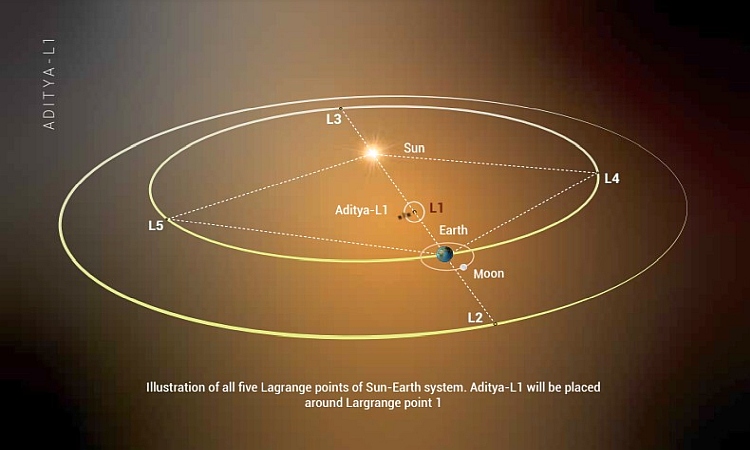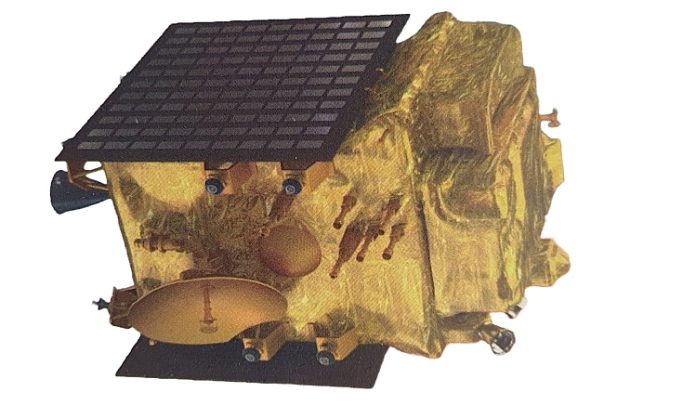Bengaluru: After achieving an unparallel feat of Chandrayaan-3 mission, the Indian Space Research Organisation (ISRO) has now girded up its loin for the launch of a solar mission—Aditya-L1—in a week’s time, likely on September 2, to study the Sun.
Aditya-L1 spacecraft is designed for providing remote observations of the solar corona and in situ observations of the solar wind at Li (Sun- Earth Lagrangian point), which is about 1.5 million kilometres from the earth.
It will be the first dedicated Indian space mission for observations of the Sun. The Aditya-L1 mission, aimed at studying the Sun from an orbit around the LI, would carry seven payloads to observe the photosphere, chromosphere and the outermost layers of the Sun, the corona, in different wavebands.
Also Read: After OneWeb launch, ISRO eyes solar & lunar missions next year
Aditya-L1 is a fully indigenous effort with the participation of national institutions, an ISRO official said. The Bengaluru-based Indian Institute of Astrophysics (IIA) is the lead institute for the development of Visible Emission Line Coronagraph payload. While Inter-University Centre for Astronomy and Astrophysics, Pune, has developed the Solar Ultraviolet Imager payload for the mission.
The mission will also provide a close observation on the corona, and on the solar chromosphere using the UV payload and on the flares using the X-ray payloads. The particle detectors and the magnetomete payload can provide information on charged particles and the magnetic field reaching the halo orbit around LI.

The satellite, realised at U R Rao Satellite Centre here, has arrived at the ISRO’s spaceport of Sriharikota in Andhra Pradesh, two weeks ago. “Most likely the launch will take place on September 2,” an ISRO official said.
The spacecraft is planned to be placed in a halo orbit around the Li of the Sun-Earth system. A satellite placed in the halo orbit around the Li point has the major advantage of continuously viewing the Sun without any occultation/ eclipses, ISRO noted.
Also Read: Chandrayaan-3’s lander reaches Moon surface, Isro creates history
“This will provide a greater advantage of observing the solar activities and its effect on space weather in real time,” it said.
Using the special vantage point Li, four payloads directly view the Sun and the remaining three payloads carry out in-situ studies of particles and fields at the LI, thus providing important scientific studies of the propagatory effect of solar dynamics in the interplanetary medium.
“The suits of Aditya L1 payloads are expected to provide most crucial informations to understand the problem of coronal heating, coronal mass ejection, pre-flare and flare activities and their characteristics, dynamics of space weather, propagation of particle and fields etc”, ISRO said.
Objective of Aditya-L1 mission
The major science objectives of the Aditya-L1 mission are: Study of solar upper atmospheric (chromosphere and corona) dynamics; Study of chromospheric and coronal heating, physics of the partially ionised plasma, initiation of the coronal mass ejections, and flares; Observe the in-situ particle and plasma environment providing data for the study of particle dynamics from the Sun.
Also Read: ISRO readies for Chandrayaan-3 landing; people seek divine blessing
They also include Physics of solar corona and its heating mechanism; Diagnostics of the coronal and coronal loops plasma: Temperature, velocity and density; Development, dynamics and origin of CMEs; Identify the sequence of processes that occur at multiple layers (chromosphere, base and extended corona) which eventually leads to solar eruptive events; Magnetic field topology and magnetic field measurements in the solar corona; Drivers for space weather (origin, composition and dynamics of solar wind).
Trajectory of Aditya-L1
The Aditya-L1 mission will be launched by ISRO’s PSLV XL rocket from Satish Dhawan Space Centre SHAR (SDSC-SHAR), Sriharikota. Initially, the spacecraft will be placed in a Low Earth Orbit. Subsequently, the orbit will be made more elliptical and later the spacecraft will be launched towards the Lagrange point (L1) by using onboard propulsion.
As the spacecraft travels towards L1, it will exit the Earth’s gravitational Sphere of Influence (SOI). After exit from SOl, the cruise phase will start and subsequently the spacecraft will be injected into a large halo orbit around L1. The total travel time from launch to L1 would take about four months for Aditya-L1. The Trajectory of Aditya-L1 mission is shown in the figure below.

Aditya-L1 Payloads
VELC: Visible Emission Line Coronagraph is designed to study solar corona and dynamics of coronal mass ejections. The payload developed by Indian Institute of Astrophysics, Bengaluru in close collaboration with ISRO.
SUIT: Solar Ultra-violet Imaging Telescope to image the Solar Photosphere and Chromosphere in near Ultra-violet (UV) and, to measure the solar irradiance variations in near UV. The payload is developed by Inter University Centre for Astronomy and Astrophysics, Pune in close collaboration with ISRO.
Also Read: NASA, ISRO to launch Nisar satellite for dipper study of earth
SoLEXS & HELIOS: Solar Low Energy X-ray Spectrometer and High Energy L1 Orbiting X-ray Spectrometer are designed to study the X-ray flares from the Sun over a wide X-ray energy range. Both these payloads are developed at U R Rao Satellite Centre, Bengaluru
ASPEX & PAPA: Aditya Solar wind Particle Eperiment (ASPEX) and Plasma Analyser Package for Aditya (PAPA) payloads are designed to study the solar wind and energetic ions, as well as their energy distribution. ASPEX is developed at Physical Research Laboratory, Ahmedabad, while PAPA has been designed at Space Physics Laboratory, Vikram Sarabhai Space Centre, Thiruvananthapuram.
MAG: Magnetometer payload is capable of measuring interplanetary magnetic fields at the L1 point. The payload is developed at Laboratory for Electro Optics Systems, Bengaluru.
The Sun
Our Sun is the nearest star and the largest object in the solar system. The estimated age of sun is about 4.5 billion years. It is a hot glowing ball of hydrogen and helium gases. The distance to the sun from the earth is about 150 million kilometres, and is the source of energy for our solar system. Without the solar energy the life on earth, as we know, can not exist. The gravity of the sun holds all the objects of the solar system together.
Also Read: SpaceX gets praise for ‘failed’ test flight of Starship
At the central region of the sun, known as ‘core, the temperature can reach as high as 15 million degree Celsius. At this temperature, a process called nuclear fusion takes place in the core which powers the sun. The visible surface of the sun known as photosphere is relatively cool and has temperature of about 5,500°C.
Why do we need to study Sun?
The sun is the nearest star and therefore can be studied in much more detail as compared to other stars. By studying the sun we can learn much more about stars in our Milky Way as well as about stars in various other galaxies.
The sun is a very dynamic star that extends much beyond what we see. It shows several eruptive phenomena and releases immense amount of energy in the solar system. If such explosive solar phenomena is directed towards the earth, it could cause various types of disturbances in the near earth space environment.
Also Read: China successfully places Tianzhou-6 cargo spacecraft into orbiting
Various spacecraft and communication systems are prone to such disturbances and therefore an early warning of such events is important for taking corrective measures beforehand. In addition to these, if an astronaut is directly exposed to such explosive phenomena, he/she would be in danger.
The various thermal and magnetic phenomena on the sun are of extreme nature. Thus, the sun also provides a good natural laboratory to understand those phenomena which cannot be directly studied in the lab.
Also Read: Russia’s lunar spacecraft, Luna-25, crashed on Moon’s surface
Why the Sun needs to be observed from space?
The sun emits radiation/light in nearly all wavelengths along with various energetic particles and magnetic field. The atmosphere of the Earth as well as its magnetic field acts as a protective shield and blocks a number of harmful wavelength radiations including particles and fields. As various radiations don’t reach the surface of the Earth, the instruments from the Earth will not be able to detect such radiation and solar studies based on these radiations could not be carried out. However, such studies can be carried out by making observations from outside the Earth atmosphere ie., from space. Similarly, to understand how the solar wind particles and magnetic field from, the Sun travel through the interplanetary space, measurements are to be performed from a point which is far away from the influence of the Earth’s magnetic field.




